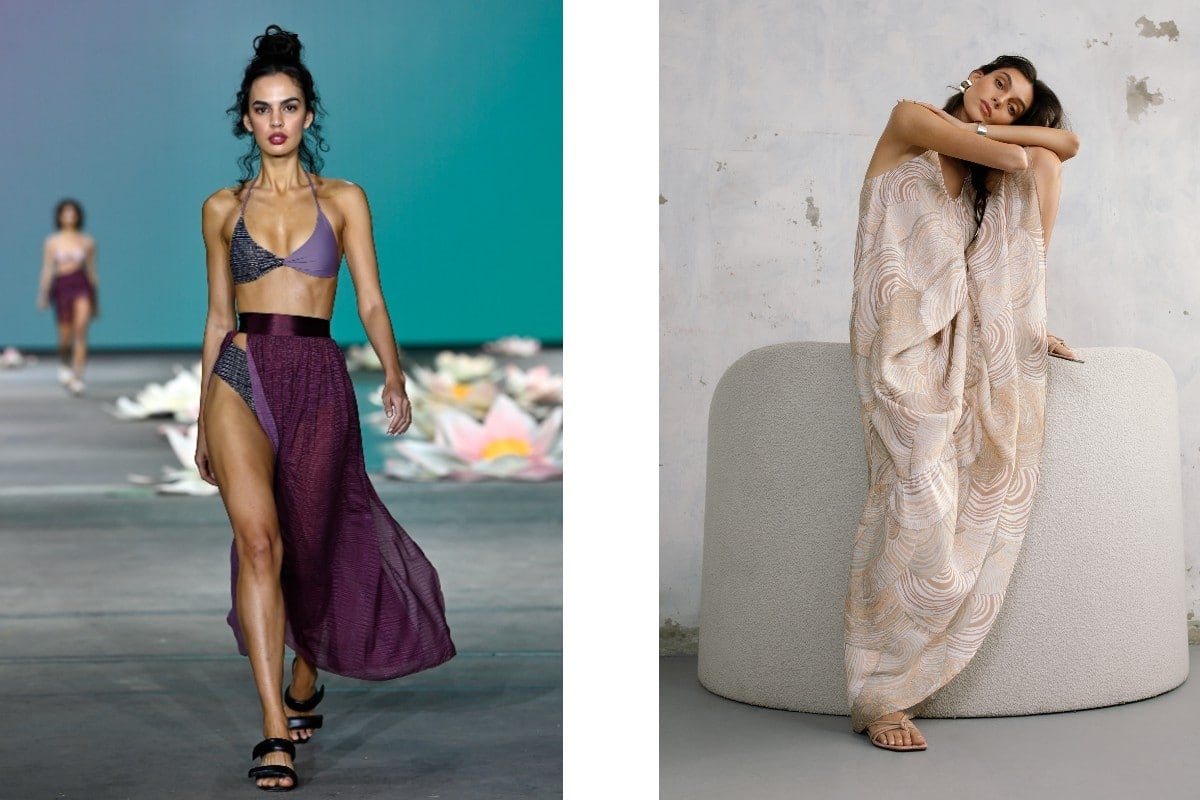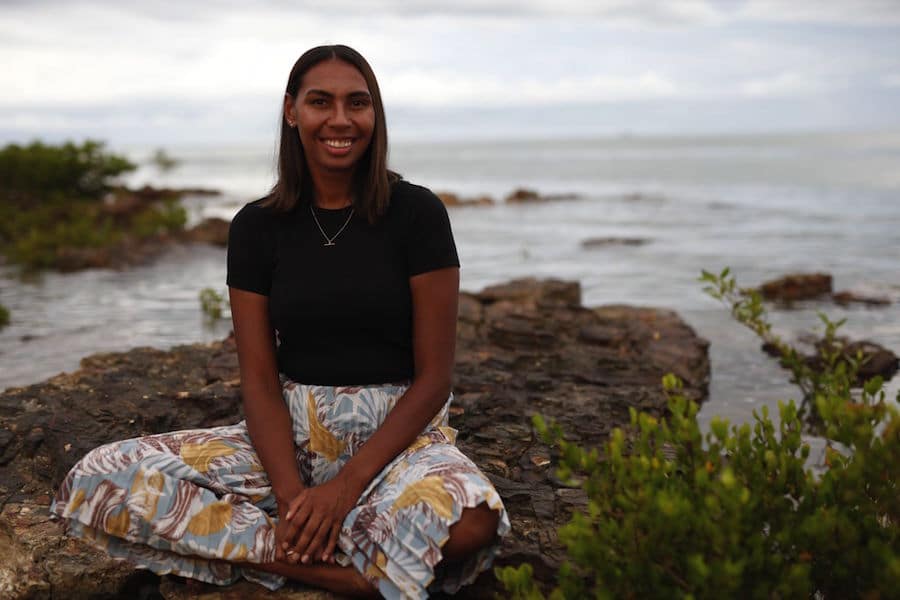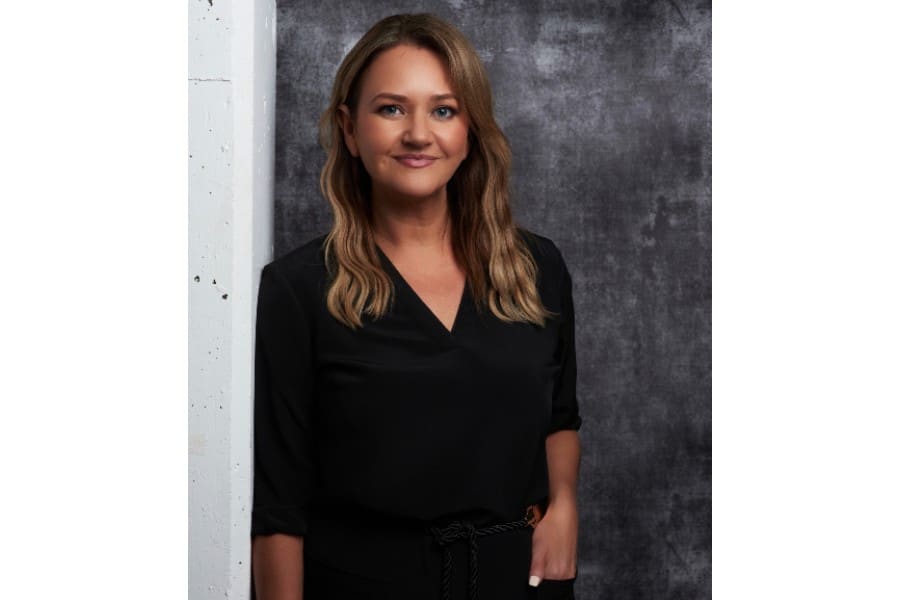
Returning to Afterpay Australian Fashion Week (AAFW) in 2022, Indigenous Fashion Projects comes together on Gadigal Country awash with colour and innovation from a selection of the brightest creatives in the country today. Labels showing include Kirrikin, Native Swimwear, Ngali, Maara Collective and Liandra Swim, with each collection drawing on the designers personal connection to Country.
An immersive journey from central Australia, through rivers and to the sea, Indigenous Fashion Projects at AAFW is a celebration of Indigenous brands and designers making their mark on the Australian fashion industry. Under the Creative Direction of Eastern Arrernte woman Shilo McNamee, the show engages with contemporary creations from the world's oldest continuous living cultures.
Designers featured at Indigenous Fashion Projects are part of the David Jones Pathways Program; supporting their brands and roles in the industry. Bridget Veals, David Jones GM of Womenswear, Footwear and Accessories, says the program is rich in industry tips and tricks, equipping designers with necessary knowledge to further their labels.
"The program provides an incredible two-way learning process for Indigenous designers to expand their reach and fine tune their growth opportunities in the global fashion industry," explains Veals. "The process is founded on the principles of listening, understanding and sharing of culture to provide an enriching experience for all our designers involved.”
We spoke with Liandra Gaykamangu of Liandra Swim and Julie Shaw of Maara Collective to unpack their creations, musings and aspirations for the future, in fruitful conversations giving a glimpse into their world as creatives.
Liandra Gaykamangu of Liandra Swim

Tell us about your background
I am a Yolngu woman from East Arnhem Land, Northern Territory. My family live on a small island, Milingimbi, and the ocean as you can imagine are a large part of who we are and how we live both in the day-to-day aspect but also culturally. I also grew up surfing and living by the ocean, as my mum remarried a surfer and he was very influential over my love of the ocean.
It was all of this – my love of the ocean from the enjoyment it has brought me throughout life, but also culturally – that led me to start a swimwear label. I love that we are able to merge all the elements of me that I love the most. Being a sustainable label is also incredibly important aspect to this, as I have always been taught to care for nature, especially from a cultural aspect.
How has your culture informed your swimwear? Does it guide you in more ways than through design aesthetics?
Our signature prints are where this is most evident, but really everything we do and in everything we are informed by my culture and the way I was raised. I hand-draw each print, with each print representing a unique story and theme. This plays heavily on the way our culture uses art forms and storytelling to share and educate.
As I mentioned, the sustainability element is also very important to me because we have a very special relationship with plants, animals and locations. It is deeper than just having totems; we are linked through kinship and have deep responsibilities to maintain and nourish our environment, which is important to me and I take this aspect of our label very seriously.
As an Indigenous designer, what does being part of Indigenous Fashion Projects at AAFW mean to you and your team?
It is an incredibly rewarding experience as I am able to learn and connect with my industry. I am also deeply honoured to represent my culture and people on such an iconic platform in the fashion industry.
Tell me about the collection showing at AAFW. What are the key motifs and pieces that you hope speak to those in the industry and consumers at large?
We will be launching our Deep Sea Collection at AAFW22. The print story and collection theme was inspired by the Mariana Trench and tectonic plates. There are elements there that have been inspired by how the thriving nature of ecosystems deep below the surface, but also how tectonic plates fit, connect and create.
Sustainability is obviously a huge part of the Liandra Swim brand, as evident through initiatives like employing recycled plastic. Is the idea of sustainability inherent to each collection from its inception?
Yes, absolutely! I am always looking to be better and do better in every way possible! We are incredibly close to being plastic-free in our packaging, which is very exciting. But, it takes time as I go through processes to test new elements to make sure they are good substitutes [and] this includes deep research and usage.
What’s your individual approach to style?
I wouldn’t say I have a particular style. I go through phases based on my emotions and how I view the world. I love bright, but I also love neutrals and dark colourways – it is truly based on each day and how I feel. This is something that can be felt and experienced through each collection, as they vary slightly in design, theme and colours!
How has your brand evolved since its inception and what are your hopes for its future?
I think I had a full circle moment last week. I started the label by having stalls and various markets and last week I was named in a US fashion magazine as being in the top 34 Australian brands to shop this summer. It was just a really lovely reminder that all the hard work was and is worth it.
Julie Shaw of Maara Collective

Tell us about your background:
I grew up in outback opal mining town of Lightning Ridge, New South wales. I am a descendant of the Yuwaalaraay people from my mother’s family and was incredibly fortunate to have grown up on my Country, surrounded by family and community. I feel that this has grounded me as a person and even though I now live in the city, whenever I go home, I truly feel that connection to my Country. This sense of knowing where I come from has informed the way that I work creatively, with culture as the foundation of my inspiration.
How have your designs and own style changed over the years?
I always aim to elevate the design aesthetic of each new collection, however keeping with our signature styles of femininity and utilising hand-made techniques like weaving knotting and tying. I feel that we are evolving from a resort-focused brand into more of a ready-to-wear lifestyle brand, and there are so many exciting opportunities to expand on our product categories through our theme of collaboration.
How does your culture inform your garments? Does it guide you in more ways than through design aesthetics?
It certainly does. There is a theme of cultural inspiration interwoven throughout the brand and that emulates in many forms, whether it be through a collaboration with an artist, the use of colour influenced strongly by the outback landscape, even down to use of language for naming of collections and styles. At the heart of the collections are our collaborations and our genuine desire to celebrate and promote Indigenous art and culture.
As an Indigenous designer, what does being part of IFP at AAFW mean to you and your team?
It’s such a fantastic platform and opportunity to showcase our work to the broader fashion community and audiences alongside Australia’s design talent, and to show what Indigenous fashion is and can be. Also, that we can stand with the best in the country.
As fashion looks to the future, implementing practices that give back to communities and the planet are par for the course. How does MAARA Collective take a holistic approach to social and environmental sustainability?
We produce 95 per cent of our product locally in Sydney. It is incredibly important to me that the collaborative pieces showcasing the works of Indigenous artists are produced here in Australia, the country from which their stories have originated.
We donate proceeds from every one of our online sales to the Buy1 Give1 Foundation, and those proceeds go toward digital skills training and education in remote Aboriginal communities. Our ‘giving back’ pillar is one that we have plans to expand and build out over the years, as we grow, always with that notion of giving back front of mind. In line with Indigenous culture, we are always searching for ways to tread lightly throughout this journey of running a clothing brand, through fabric choices, packaging options, trying to keep as low waste as possible in our product development processes.



